
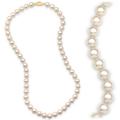
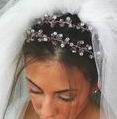
|
|
|
|
Pearls, Moonstone & Wedding Beads!
You have received this newsletter because you opted after a past purchase, but should you wish to be taken off the mailing list, just click the link at the bottom. This month’s theme is June's birthstone pearl and moonstone + we also tell you how beads can make a wedding. Scroll down, or click one of the links below on the html version to go to a certain section. If you have any suggestions for the future, please e-mail me at suggestions@mrbead.com. To go to the MrBead store click here
If you
weren't mailed this newsletter enter your e-mail address
here to receive next month's
newsletter.
How to Tell Real Pearls from Fake Pearls
Pearl Folk Lore
Pearls have always been popular – a classic that never go out of style. There are some beautiful strands of pearls these days, with amazing shapes and colors in freshwater pearls. Like pink, peach, lavender, blue, and even yellow. At one time freshwater pearls were only available as white rice shaped. Until advanced dyes in China now produce almost any color under the sun.
I believe today’s popularity has a lot to do with price. Since pearls are so affordable, they can be worn by more people. Though it still takes a few years to grow a pearl, China has developed a system that has enabled them to produce large quantities cheaply. While China’s pearl process has grown, Japan’s pearl industry has slowed down due to water pollution and high costs.
The least expensive cultured pearls today rival the most expensive natural pearls ever found. Natural freshwater pearls occur in mussels for the same reason saltwater pearls occur in oysters. Foreign material inside a mussel can't be expelled. To reduce irritation, the mollusk coats the intruder with the same secretion it uses for shell-building, nacre. To cultivate a pearl, farmers slit the mussel and insert small pieces of live tissue from another mussel.
The ancient Chinese practiced this technique, but the first real cultured freshwater pearls originated in Japan. In the 1930's, Japanese farmers by Lake Biwa achieved natural colors unseen in saltwater pearls. However, water pollution today has virtually destroyed pearl production there. China now has the resources that Japan lacks: many large lakes, rivers, and a low-cost work force. The first Chinese cultured pearls were basic, until the 1990's when China revolutionized pearling. Shapes, luster, and colors of the new Chinese pearls now surpass Biwa quality. Copying the Japanese to improve off-white and mottling, China uses a mild bleach, bright lights, and heat. Natural freshwater pearls are usually odd shapes. So for more roundness, the Chinese now reshape rejected pearls into spheres, and then nucleate mussels with them. However, the word “Biwa” can now also refer to the irregular shape of any cultured pearl.
The best pearls have thick overlapping layers of nacre. This can be tested by viewing its "luster". Roll the pearl with a pen in good light - the best pearls will reflect the pen the most. A large pearl is only more valuable if it's the same quality as a smaller one - and the rounder the better. Being an organic gem, grooves, pits, or dents are expected. However, matching color for a complete necklace is important. Freshwater pearls are popular for their colors: white, silvery-white, pink, red, copper, brown, lavender, purple, green, blue, and yellow. The most desirable are the pastel pinks, roses, lavenders, and purples. Color comes from the mussel species and water quality. Generally pearls assume the color of the shell in which they form, but permanent dyes are used today for most saturated colors. top of page
If you look very closely, you’ll see tiny knots in between each pearl bead on a necklace. Many of your finer beaded jewelry is knotted because knots keep the beads from rubbing against each other - and if the necklace breaks, beads won’t go flying. Knotting also makes the necklace drape nicely and adds length so you need less beads. Pearls should be restrung every 1-2 years, depending on the amount of wear and the exposure to hair spray, perfume, body oils, lotions, moisture, and perspiration they receive. These elements can wear and dirty the silk and cause a potential break point for the strand.
There are a few ways to knot a beaded necklace, but I’ll only tell you the easiest for beginners. First, you’ll need to choose a type of cord to use. There are two types that are usually used for knotting: silk and nylon. Silk is traditional, however many complain that it snags and frays. Nylon cord can also be used. Both come in a variety of colors. They can be purchased on small cards with about 6 feet of cord and a needle attached or, for the serious knotter, larger spools can be purchased with separate needles. They also come in different sizes. The thicker cord is used for the larger beads since the holes in the beads are larger. For the beginner’s technique, two strands are put through each bead, so a thinner size is needed. For 6mm beads, use size 2 for this technique, and try to match the color of the cord with the color of the beads.
A very-popular way to start any beaded necklace is with bead tips (clamp shells). The only difference here is that two strands of the cord are inserted through the bead tip instead of one. Once the necklace is started, string on a bead, and make an over hand knot. Make the knot tight so it’s snug up against the bead. Continue to do this: string a bead, make an over hand knot, string a bead, make an over hand knot. That’s it. Finish the necklace as you would any beaded necklace whether it’s knotted or not. This beginner’s way is a lot easier than using one strand of cord, and the results look almost the same. top of page
How to
Tell Real Pearls from Fake Pearls
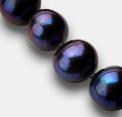

If you are buying pearls, you may be able to identify fake pearls by their name: simulated, faux, glass, plastic, resin, artificial, manmade. Genuine pearls are usually either natural or cultured. Real pearls may come from freshwater or saltwater and from a variety of molluscs (not just oysters). They are both formed from the same material and both are found in "baroque" shapes as well as round. It is also very difficult to tell whether a pearl comes from saltwater or freshwater. To further confuse things, there are also shell pearls and genuine pearls which have been treated, such as coatings or faceting. Before you buy or sell pearls, you need to know whether they are real or not. Here are some ways to tell them apart:
Close Inspection

Take your pearls out into the sun or hold them under a bright light. Unless they are very expensive, genuine pearls won't look perfectly matched. You will be able to see variations in their iridescence (orient) and color. If the pearls are perfectly matched for color and overtones, they are most probably fake.
If your pearl seller offers expensive pearls that are perfectly matched, the cost of a gemologist certificate (from a gemologist of your choice) is a minimal part of the investment. It costs about $150 to have pearls tested, as opposed to several thousands of dollars for the type of pearls that warrant the test. An x-ray will show the inside of the pearl, including variations in density, the presence or absence of a parasite that might have caused the formation of a natural pearl, and the characteristic shapes of drill holes.
As is true with diamonds, magnification reveals a lot about the quality of a pearl. You can see the characteristic ridges and irregularities of real pearls or the grainy smoothness of fakes. You can examine drill holes to see the interface between the nacre and what lies beneath it. You can read any writing on the clasp or setting.
Cutting a pearl open will reveal its true nature. Natural pearls are comprised of many layers of nacre. Cultured pearls have a shell (mother-of-pearl) core covered with a thin layer of nacre (usually less than half a millimeter). Fake pearls have a core with one or more layers of coating applied to them, which tends to flake away from the core upon cutting.
You can also try the tooth test. Rub the surface of the pearl over your teeth. Supposedly a real pearl feels gritty while a faux pearl feels smooth. Real pearls are made up of layers of nacre that are deposited like sand on a beach. The slight waves in the nacre can produce a bumpy feeling against the teeth. However, if the pearls are dyed, the dye can fill in natural depressions, making them feel smooth. Also, some synthetic pearls are made to look and feel like real pearls. top of page
Other Clues
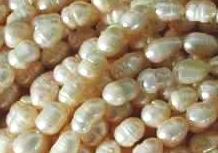
Fakes usually look 'flat'. Real pearls are usually not perfect - having grooves in their nacre, bumps, ridges, or pits. They vary in size and shape from one to another. These rings and grooves of genuine pearls can make inexperienced people think the marks are from molding of a fake. Real pearls come in many shapes, tending not to be perfectly round, so a perfect sphere should be suspect. Expensive genuine pearls may be round, so you must check other clues. Some fakes are made to look irregular, and glass pearls often have flattened ends or slightly oval shapes. Also, genuine pearls tend to warm to the skin faster than glass pearls - but plastic pearls tend to feel warm right away. Real pearls are usually heavier for their size than plastic, resin, or hollow glass pearls.
Real pearls are usually drilled from both sides, to meet in the center. If you could see the cross section of the pearl, the hole may appear wider at the outside edge of the pearl than at the center (which can make stringing poorly-drilled pearls difficult). Inexpensive real pearls may be cheaper because the drill holes are not completely straight, (knotting can get around this problem when making a necklace). Holes of real pearls usually are as small as possible, since the weight of a pearl affects its price. Fakes often have larger, possibly straighter holes. The nacre of fake pearls is more likely to flake away near the drill hole than on a cultured pearl (it won't flake on a natural pearl). And holes of fake pearls usually form a shallow bowl shape, while the holes of real pearls are more likely to be flat.

If you see the Mona Lisa in someone's home, you can be pretty sure it isn't the original! Similarly, you can gain valuable clues about a pearl's authenticity by looking at its surroundings. In a finished necklace or bracelet, real pearls are more likely to have knots between each pearl than faux pearls. Real pearls are usually set in gold, silver, or platinum. You can examine clasps for stamps in the metal or for magnetism (indicating the clasp or setting contains iron as opposed to a precious metal). The clasp should have a safety mechanism, like a fish hook. Insecure clasps are not usually seen on good pearls. top of page
There are an almost infinite number of myths and folk lore associated with pearls. Many pearl web sites included their own version of pearl myths. Here are a few that I found:
• Pearls have the powers of love, money, protection, and luck.
• Pearls were dedicated by the Romans to Isis and they were worn to obtain her favor.
• In early Chinese myths, pearls fell from the sky when dragons fought among the clouds.
Pearl Care

Special care is needed for pearls. Since they are naturally porous, it’s
important to make sure they do not absorb cologne, hair spray, lotions, or make
up. Although oils from your skin help keep the pearls from drying out. Pearl
jewelry is often purchased in a silk or felt pouch. You should keep the pearls
in this to prevent scratches. To clean pearls, don’t use any jewelry cleaners –
wipe gently with a damp cloth. top of page
Moonstone - Nature’s treasure with a sensuous and seductive charm!
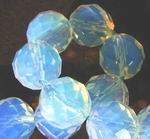

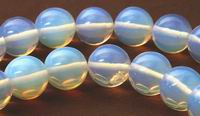
Moonstone’s characteristic feature is a magical play of light. Moonstone is
translucent, and softens the light shining through it to give a pearly moon-like
glow which appears different whenever the stone changes its position. Years ago,
thought to be brought upon by the moon’s phases. This shimmering affect is
called adularescence, and is caused by light being refracted inside the stone
and scattered. Moonstone comes in colorless, white, grey, and subtle yellow, but
always has a blue or white sheen. Rainbow moonstone is colorless with a blue
sheen and a rainbow-like array of colors.
Much mystery surrounds this stone. In India it’s considered sacred to lovers,
and is also known as a “dream stone” bringing beautiful dreams. In Arab
countries women often were moonstone sewn into their garment as a symbol of
fertility. It was also believed to be especially protective to seafarers, who
have been using it since ancient times. During full-moon, moonstone is very
powerful for reconciling love - and as the moon decreases, is said to allow one
to foretell the future.
A feminine stone for the inner-child, female issues and nurturing - but also
used by men who want to reach their female side and to understand dreams.
Moonstone brings confidence and calms the emotions, and aids spirituality,
intuition, and clairvoyance. Also known to protect against fever, dropsy,
fluid-retention and urinary problems. Its soft shine will support the emotional
and dreamy tendencies of a person. Wearing moonstone will also increase your
sensitivity for others.

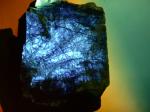
Classical moonstone from Sri Lanka shimmers pale blue on almost transparent
ground. Moonstone from India has cloudlike plays of light on beige, brown,
green, or orange backgrounds – and some have a cat’s eye or a multi-rayed star.
Since blue moonstones in fine qualities have become scarce in recent time, the
prices have increased. An uncut moonstone looks boring and lacks the play
of light. This is brought out by the cutter’s skills, who must locate the
crystal axis exactly in the zenith of the stone. Classical moonstones are always
cut as cabochons. Moonstone is fragile and should be handled carefully. However,
a jeweler can polish a dulled moonstone back to its original glory.
When purchasing moonstone you will find astonishing differences in price. The
more intense the color, the larger and more transparent the stone, the more
valuable is the gem. Really top quality fine blue moonstone shows an incredible
“three-dimensional” depth of color, which you will see clearly only when tilting
the stone. Such specimens are rare and accordingly valued. Brighter colored
Indian moonstones are usually less expensive, so are opalite moonstone. top of page
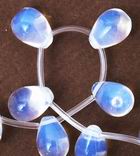
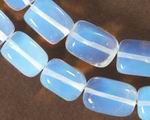
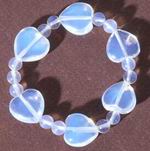
Opalite moonstone is most common today – this looks similar to genuine
moonstone, but is man made. Opalite is a synthetic stone that's only been around
for the past decade or so. Also called opalized glass, the stone has two
personalities. Against a light background, it's milky white and has golden
highlights mixing with faint lilac-blue and other colors around the stone. The
pastel glow is soft and captivating, and it compliments other light-colored
stones like lilac amethyst, blue chalcedony, and rose quartz. Opalite, under
these circumstances, will add a romantic feminine allure to your beaded jewelry.
Once opalite is placed against a darker background, though, the whole stone
changes to a bright icy blue. The golden highlights also change to intense
oranges and reds, like the "fires" you see in opals. The stone practically glows
on its own, and demands attention by outshining the stones around it. It loves
to compete with bright colors like fuchsias and turquoise. This is the edgier,
more distinctive side of opalite that makes it perfect to wear during the night
out in the town. The great thing is, opalite always looks refreshingly
cool, whether it's milky white or flashy blue - ideal for summer jewelry. By
being creative with your outfits, you can really have fun wearing the stone. A
beaded belt made with opalite, for example, can become the perfect summer
accessory to a brightly colored evening dress.
top of page
There are so many ways beads can add an individual touch to a wedding. On gowns, wraps, purses, tiaras, hairpins, and in flower arrangements. Plus the more-obvious uses like necklaces, earrings and bracelets - for mum, mother-in-law, the bridesmaids and special friends. These make excellent lasting and unique thank you gifts. A nice necklace, bracelet and earrings will complement their dresses. Incorporating beads into your wedding will bring you joy in unexpected ways – time spent with friends, creating pieces that are unique, and an escape from the stress of planning.
White or subtle shades of pink freshwater pearls are ideal for wedding jewelry. These can be purchased most economically by the strand, temporarily strung. One strand can easily be divided to make three or four floating necklaces, a popular wedding option. Floating necklaces have beads crimped in place either individually or in small groups, to give the appearance of floating on a fine wire. Multi-stranded floating necklaces are striking too. Freshwater pearl earring can be inexpensively brought or you can make them yourself with sterling silver wire.
Beading for Gowns
 Tiny 3mm Swarovski crystals with or without an aurora
borealis, shiny, light-reflecting coating, and silver-lined seed beads are the
favorites for beading gowns. They add interest to the dress and show up great
on the photographs, especially as the wedding photographer will feature the
bride’s and bridesmaid’s gowns. You can sew subtle little shapes, like flowers
or butterflies, onto the gown using tiny seed beads - and longer patterns
running right down the length of the dress look effective too. Keep the bead
color the same or similar to the gown, so as not to take away the dress’s
elegance.
Tiny 3mm Swarovski crystals with or without an aurora
borealis, shiny, light-reflecting coating, and silver-lined seed beads are the
favorites for beading gowns. They add interest to the dress and show up great
on the photographs, especially as the wedding photographer will feature the
bride’s and bridesmaid’s gowns. You can sew subtle little shapes, like flowers
or butterflies, onto the gown using tiny seed beads - and longer patterns
running right down the length of the dress look effective too. Keep the bead
color the same or similar to the gown, so as not to take away the dress’s
elegance.
Some Gift Ideas
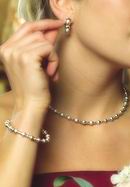
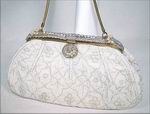 Beaded keyrings are a favorite, and a good men’s gift.
Little beaded animals are fun, pin brooches are easy to make, and wine glass
identifiers (different colored beaded rings to slip on the bottom of your
guests’ wine glasses) are popular too. Someone who wears specs may well
appreciate a fine bead-on-silk thread “necklace” to keep their glasses around
their neck when not being worn.
Beaded keyrings are a favorite, and a good men’s gift.
Little beaded animals are fun, pin brooches are easy to make, and wine glass
identifiers (different colored beaded rings to slip on the bottom of your
guests’ wine glasses) are popular too. Someone who wears specs may well
appreciate a fine bead-on-silk thread “necklace” to keep their glasses around
their neck when not being worn.
Special Offer Worth $12!
Sample our beads with an $12 discount from any order over $20 before shipping
in our MrBead bead store, just key in "80606" at the checkout (without the
inverted commas) and click "Redeem Coupon".
Offer valid until 8th June only - so act now! Only for use in our store at the checkout and not valid with any other offers.
To see all our pearls click here
To see all our moonstone click here
To see all our beads at MrBead click http://www.mrbead.com
To return to the top of this page click here